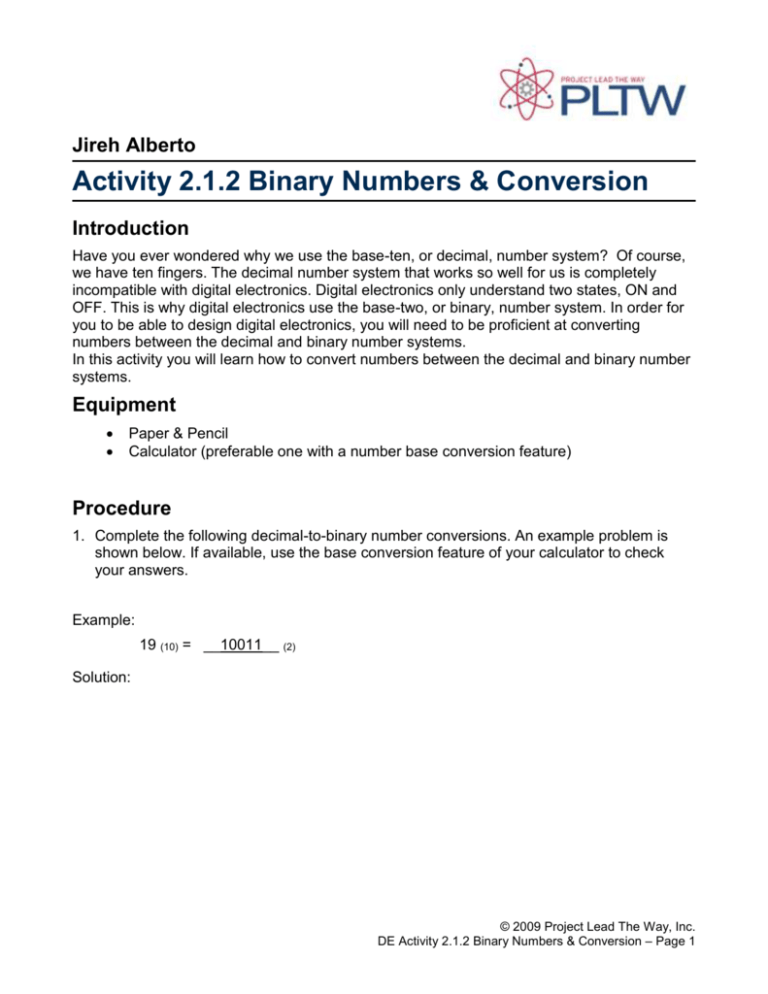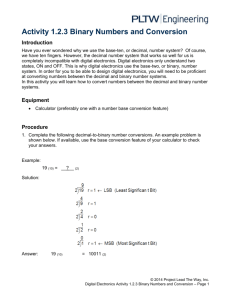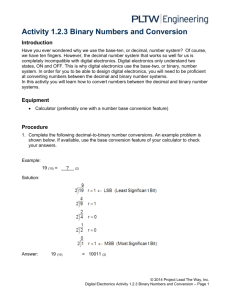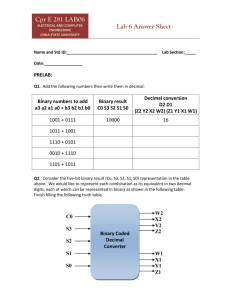2.1.2.A Binary Numbers & Conversion
advertisement

Jireh Alberto Activity 2.1.2 Binary Numbers & Conversion Introduction Have you ever wondered why we use the base-ten, or decimal, number system? Of course, we have ten fingers. The decimal number system that works so well for us is completely incompatible with digital electronics. Digital electronics only understand two states, ON and OFF. This is why digital electronics use the base-two, or binary, number system. In order for you to be able to design digital electronics, you will need to be proficient at converting numbers between the decimal and binary number systems. In this activity you will learn how to convert numbers between the decimal and binary number systems. Equipment Paper & Pencil Calculator (preferable one with a number base conversion feature) Procedure 1. Complete the following decimal-to-binary number conversions. An example problem is shown below. If available, use the base conversion feature of your calculator to check your answers. Example: 19 (10) = __10011__ (2) Solution: © 2009 Project Lead The Way, Inc. DE Activity 2.1.2 Binary Numbers & Conversion – Page 1 Answer: 19 (10) = 10011 (2) a) 17 (10) = 10001 b) 34 (10) = 100010 c) 58 (10) = 111010 (2) d) 92 (10) = 1111100 (2) e) 119 (10) = 1110111 (2) f) 178 (10) = 10110010 g) 297 (10) = 100101001 h) 413 (10) = 110011101 (2) (2) (2) (2) (2) 2. Complete the following binary-to-decimal number conversions. An example problem is shown below. If available, use the base conversion feature of your calculator to check your answers. Example: 101001 (2) = __41__ (10) Solution: © 2009 Project Lead The Way, Inc. DE Activity 2.1.2 Binary Numbers & Conversion – Page 2 Answer: 101001 (2) = 41 (10) a) 1100 (2) = _____12(10) b) 11010 = ____26(10) (2) c) 111001 (2) = ____57(10) d) 1010011 (2) = ______83(10) e) 10000101 (2) = ____133(10) f) 10011001 (2) = ____153(10) g) 100100001 (2) = _____288(10)) h) 111101010 (2) = _____490(10) © 2009 Project Lead The Way, Inc. DE Activity 2.1.2 Binary Numbers & Conversion – Page 3 3. Perform the remaining decimal-to-binary conversions to complete the table shown below. Decimal Number Binary Number MSB LSB 0= 0 0 0 1= 0 0 1 2= 0 1 0 3= 0 1 1 4= 1 0 0 5= 1 0 1 6= 1 1 0 7= 1 1 1 © 2009 Project Lead The Way, Inc. DE Activity 2.1.2 Binary Numbers & Conversion – Page 4 Conclusion 1. The decimal number system has served humans well since the beginning of mankind. Ug the caveman didn’t call it the decimal number system, but he undoubtedly used his fingers to count objects in his world. If the decimal system is so good, why do computer and other digital electronic devices use the binary number system? The use of the # 0 & 1 during circuits tells which component is either on or off. 2. Now that we are using a number system other the decimal, it is important to properly subscript our numbers (i.e., 3510, 23410, 100102, etc.). Why is this so important? Provide at least three examples where neglecting to subscript numbers could lead to confusion. If certain #s are not properly subscripted the new # can be completely different. 3. Without performing the binary-to-decimal conversions, which of the following two binary numbers is the larger number : 101101 (2) 011010 (2) 4. How were you able to determine this? Since the most significant digit in the first # is 1, it will then have a greater #. 5. Perform the binary-to-decimal conversions and check your answer. Were you correct? I was correct 6. Examine the table that you completed in the procedure portion of the activity. What do you notice about the LSB (least-significant-bit)? What do you notice about the middle bit? What do you notice about the MSB (most-significant-bit)? Do you observe a pattern here? In the LSB column the numbers 0 and 1 alternate. In the middle bit the numbers alternate every two times. In the MSB column the 0 and 1 have an equal amount. 7. Based on your observations above, complete the table shown below. Decimal Number 0 1 2 3 4 5 6 7 8 = = = = = = = = = Binary Number MSB 0 0 0 0 0 0 0 0 1 LSB 0 0 0 0 1 1 1 1 0 0 0 1 1 0 0 1 1 0 0 1 0 1 0 1 0 1 0 © 2009 Project Lead The Way, Inc. DE Activity 2.1.2 Binary Numbers & Conversion – Page 5 9 = 10 = 11 = 12 = 13 = 14 = 15 = 1 1 1 1 1 1 1 0 0 0 1 1 1 1 0 1 1 0 0 1 1 1 0 1 0 1 0 1 Going Further – Optional 1. What number system do you think the cartoon character at the right would use? (Hint: count the fingers). Based on the wellestablished fact that all space aliens have only three fingers on each hand, what number system do you think aliens would use? I believe the cartoon character would use a number system dealing with four and the alien number system would be in threes. 2. Use your conclusions above to complete the following conversion table. Decimal Number Binary Number Cartoon Number Alien Number 35 100011 1029 247 22 10110 267 93 © 2009 Project Lead The Way, Inc. DE Activity 2.1.2 Binary Numbers & Conversion – Page 6





